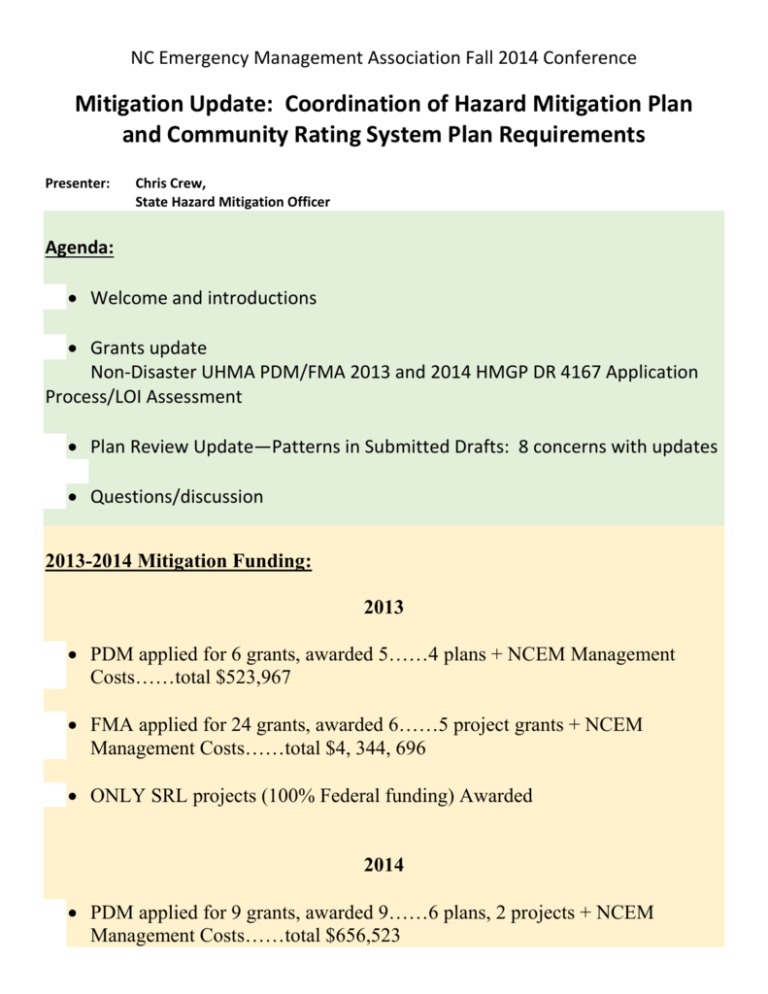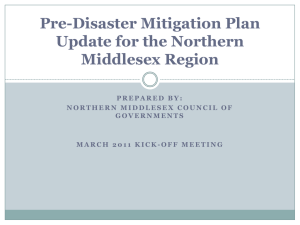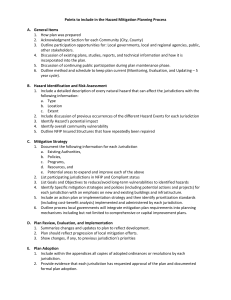File
advertisement

NC Emergency Management Association Fall 2014 Conference Mitigation Update: Coordination of Hazard Mitigation Plan and Community Rating System Plan Requirements Presenter: Chris Crew, State Hazard Mitigation Officer Agenda: Welcome and introductions Grants update Non-Disaster UHMA PDM/FMA 2013 and 2014 HMGP DR 4167 Application Process/LOI Assessment Plan Review Update—Patterns in Submitted Drafts: 8 concerns with updates Questions/discussion 2013-2014 Mitigation Funding: 2013 PDM applied for 6 grants, awarded 5……4 plans + NCEM Management Costs……total $523,967 FMA applied for 24 grants, awarded 6……5 project grants + NCEM Management Costs……total $4, 344, 696 ONLY SRL projects (100% Federal funding) Awarded 2014 PDM applied for 9 grants, awarded 9……6 plans, 2 projects + NCEM Management Costs……total $656,523 FMA applied for 14 grants awarded 9……8 projects + NCEM Management Costs……total $10,356,892 ONLY SRL projects (100% Federal funding) Awarded HMGP DR 4167 Severe Winter Weather March 6-7, 2014 Estimated funding $9,200,000 Prioritized Central Branch Counties for project and plan funding Rec’d 28 LOIs for 5% projects……12 LOIs for brick and mortar projects......1 Plan application……totaling $13,000,000+ from Central Branch Only Will complete eligibility and prioritization review and begin submitting to FEMA via NEMIS in October Eight Common Revision Requests from FEMA NC is starting on a five-year update cycle that will last through 2018 and include the update of both the State 322 Plan and all of the 53 Local/Regional Hazard Mitigation Plans. NCEM is partnering with the UNC System and the NC Community College System to develop a Hazard Mitigation Plan for each of the Community College Campuses in NC. During update of the CC Plans beginning in 2019, we anticipate a roll-up of those plans into the corresponding Regional/Local HMP. To date, we have reviewed 6 plans and submitted 4 Draft Updates to FEMA. Following are 8 common revision requirements we are seeing: Element A1. DOES THE PLAN DOCUMENT THE PLANNING PROCESS, INCLUDING HOW IT WAS PREPARED AND WHO WAS INVOLVED IN THE PROCESS FOR EACH JURISDICTION? Plan must provide, at a minimum, the jurisdiction represented and the person’s position or title and agency within the jurisdiction. For each jurisdiction seeking plan approval, the plan must document how they were involved in the planning process. Jurisdictions that adopt the plan without documenting how they participated in the planning process will not be approved. Solution: Rosters and sign-in sheets from ALL planning meetings/MAC meetings/Public Meetings— Identify participants by name and title. Page 15 of guide Element B3. IS THERE A DESCRIPTION OF EACH IDENTIFIED HAZARD’S IMPACT ON THE COMMUNITY AS WELL AS AN OVERALL SMMARY OF THE COMMUNITY’S VULNERABILITY FOR EACH JURISDICTION. The plan must provide an overall summary of each jurisdiction’s vulnerability to the identified hazards. This means more than a list of the total exposure of population, structures, and critical facilities. An overall summary is a list of key issues or problem statements that clearly describes the community’s greatest vulnerabilities and that will be addressed in the mitigation strategy. Solution: Write vulnerability NARRATIVE FOR EACH PARTICIPATING JURISDICTION—explain the vulnerability to “someone who isn’t from around here.” Page 20 of guide Element C1. DOES THE PLAN DOCUMENT EACH JURISDICTION’S EXISTING AUTHORITIES, POLICIES, PROGRAMS AND RESOURCES, AND ITS ABLITY TO EXPAND ON AND IMPROVE THESE EXISTING POLICIES AND PROGRAMS? The plan must describe each jurisdiction’s existing authorities, policies, programs and resources available to accomplish hazard mitigation. If local jurisdiction allows county to manage all aspects of a specific local program then this should be described. Solution: Tell us about your local staff and what they do—Planning, Public Works, Inspections, Economic Development, Emergency Management. Tell us about local plans—Comprehensive Plans, Unified Development Ordinances, CAMA Plans, Zoning and Building Ordinances, etc, etc, etc. Page 23 Element C2. DOES THE PLAN ADDRESS EACH JURISDICTION’S PARTICIPATION IN THE NFIP AND CONTINUED COMPLIANCE WITH NFIP REQUIREMENTS, AS APPROPRIATE? The plan must describe each jurisdiction’s participation in the NFIP and describe their floodplain management program for continued compliance. Simply stating “The community will continue to comply with NFIP,” will not meet this requirement. Jurisdictions that are currently not participating in the NFIP may meet this requirement by describing the reasons why the community does not participate. Solution: Tell us WHAT you are doing to manage your community’s participation: Scheduled CAVs, Recent CAV results, ADOPTION AND ENFORCEMENT OF PROGRAM--process for review of new development applications; process for on-going inspections of flood plain properties to insure continued compliance; MAPPING UPDATES AND ADOPTION; public outreach efforts—water bill stuffers, public notices, public meetings, websites, etc. Page 23 Element C4. DOES THE PLAN IDENTIFY AND ANALYSE A COMPREHENSIVE RANGE OF SPEFICIF MITIGATION ACTIONS AND PROJECTS FOR EACH JURISDICTION BEING CONSIDERED TO REDUCE THE EFFECTS OF HAZARDS, WITH EMPAHSIS ON NEW AND EXISTING BUILDINGS AND INFRASTRUCTURE? Must have a comprehensive range of different hazard mitigation alternatives that address the vulnerabilities to the hazards that the jurisdiction(s) determine are most important. Solution: Describe a minimum of 2 actions per hazard and identify actions that address old and new structures and infrastructure as well as limiting risk to new development and redevelopment. Be sure and include both PREVENTION measures like zoning and land use planning, AND include some PROPERTY PROTECTION measures like elevation/acquisition/relocation of structures and critical facilities; DON’T RELY SOLELY on education and outreach, response, and preparedness measures. “Making sure the fire truck always has ½ a tank of gas and a charged battery” is PREPAREDNESS, not mitigation. Page 24 Element C4. (CONTINUED) A timeframe of “ongoing” is not acceptable in any of the mitigation action plans. A timeframe within the five-year span of the hazard mitigation plan is acceptable. This applies to both the REVIEW of Previous Mitigation Actions AND timeframes for NEW ACTIONS. If your measure is “continue to provide plan reviews and permits for floodplain development” describe how many you did in the last five years for the update, and describe how many you anticipate conduction in the NEXT FIVE years based on the number of buildable lots, average annual number of permits/inspections over last period, etc. Remember to explain it to “folks who aren’t from around here.” Page 24 Element C6. DOES THE PLAN DESCRIBE A PROCESS BY WHICH THE LOCAL GOVERNMENTS WILL INTEGRATE THE REQUIREMENTS OF THE MITIGATION PLAN INTO OTHER PLANNING MECHANISMS, SUCH AS COMPREHENSIVE OR CAPITAL IMPROVEMENT PLANS, WHEN APPROPRIATE? A multi‐jurisdictional plan must describe each participating jurisdiction’s individual process for integrating hazard mitigation actions applicable to their community into other planning mechanisms. The updated plan must describe how the mitigation strategy, including the goals and hazard mitigation actions will be incorporated into other planning mechanisms. Solution: Narrative description of HOW members of various interested parties, (EM, Planning, etc) are working together to make sure various plans and processes are checked for consistency. You MIGHT want to add a column to your mitigation measures table to identify OTHER PLANS OR AGENCY ACTIONS impacted by the mitigation measure. Page 25. Element D2. WAS THE PLAN REVISED TO REFLECT PROGRESS IN LOCAL MITIGATION EFFORTS? Plan must describe the status of hazard mitigation actions in the previous plan by identifying those that have been completed or not completed. For actions that have not been completed, the plan must either describe whether the action is no longer relevant or be included as part of the updated action plan and describe any activity that has been accomplished since the last plan update. Solution: Narrative description of progress toward goals, analysis of successes/incomplete actions—what went right/what went wrong. SOME of your completed actions might become capabilities. If you included “earn CRS Credit” as a measure or action in your last plan, and you succeeded, discuss it in your capabilities section and consider a new measure of IMPROVING your CRS rating. Page 27







